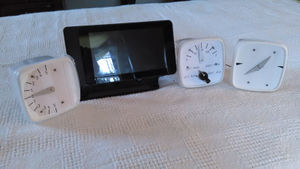APionics: Difference between revisions
Jump to navigation
Jump to search
mNo edit summary |
No edit summary |
||
| Line 1: | Line 1: | ||
{{FlightGearRaspberryPi4 Navigation}} | {{FlightGearRaspberryPi4 Navigation}} | ||
{{lowercase title}} | {{lowercase title}} | ||
'''aPionics''' | '''aPionics''' uses the Raspberry Pi to drive external avionic instruments. | ||
[[File:APionics.jpg|thumb|Cockpit instruments controlled by a Raspberry Pi.]] | [[File:APionics.jpg|thumb|Cockpit instruments controlled by a Raspberry Pi.]] | ||
==Instrument Needles== | |||
Roof flashing makes a suitable material for making the instrument needles. | |||
==Instrument Housings== | |||
The housings are up-cycled food containers from the local deli. There are a few possible advantages to making stand alone gauges. | |||
Possible Advantage | |||
* Can be used on a desk. | |||
* Later they could be installed into a panel. | |||
* Can be using the ones made while the next instrument is being developed. | |||
* If one instrument is lacking, it can be used while an upgrade instrument is being worked on. | |||
==Fuel Gauge== | |||
[[File:Fuel Gauge DC-3.jpg|thumb|150px|Inside of the fuel gauge, made for the DC-3]] | |||
The inside of the fuel gauge is shown in the photo. The needle movement is accomplished with a hobby servo. The fuel tank selector switch takes advantage of one of the Analog to Digital Converter (ADC) that the TINKERplate has. The resistor, soldered to the rotatory switch is a simple voltage divider. Every used switch position is assigned a voltage level that corresponds to a specific fuel tank. | |||
Revision as of 01:07, 23 January 2021
aPionics uses the Raspberry Pi to drive external avionic instruments.
Instrument Needles
Roof flashing makes a suitable material for making the instrument needles.
Instrument Housings
The housings are up-cycled food containers from the local deli. There are a few possible advantages to making stand alone gauges.
Possible Advantage
- Can be used on a desk.
- Later they could be installed into a panel.
- Can be using the ones made while the next instrument is being developed.
- If one instrument is lacking, it can be used while an upgrade instrument is being worked on.
Fuel Gauge
The inside of the fuel gauge is shown in the photo. The needle movement is accomplished with a hobby servo. The fuel tank selector switch takes advantage of one of the Analog to Digital Converter (ADC) that the TINKERplate has. The resistor, soldered to the rotatory switch is a simple voltage divider. Every used switch position is assigned a voltage level that corresponds to a specific fuel tank.

